Abstract
This article describes the recycling of coarse and fine fractions and powder from construction and demolition waste (CDW) using alkaline activation technology (geopolymerization). The CDW sample used corresponds to a mixture (mixed waste) of concrete (Co), ceramics (Ce) and masonry (M). Co, Ce and M (CDW-Mixed) powders were used as geopolymer precursors. As an alkaline activator, a mixture of sodium hydroxide (NaOH) and sodium silicate (Na2SiO3) was used. From CDW-Mixed, a hybrid cement added with 10% ordinary Portland cement (OPC) was synthesized to promote curing at room temperature (25 °C). From the alkali-activated hybrid cement and the incorporation of mixed recycled aggregates (gravel and sand), applications of mortars, concretes, fiber-reinforced materials and prefabricated units, such as solid blocks, perforated (hollow) blocks and pavers, were produced. The results of the physical–mechanical characterization validate the application potential of these CDW-based materials in the construction sector. Compressive strengths of up to 40.5 MPa for mortar and 36.9 MPa for concrete were obtained after 90 days of curing at room temperature ≈ 25 °C. Similarly, a life cycle analysis (LCA) associated with raw materials demonstrated the environmental sustainability (44% lower carbon footprint) of mixed alkali-activated CDWs compared to conventional materials based on OPC.
1. Introduction
Construction and demolition waste (CDW) represents 25–30% of worldwide total solid waste [1], and it is estimated that its generation exceeds 3 billion tons/year [2]. Faced with this alarming environmental problem, the recycling of CDW is considered essential for the construction sector to be sustainable in a circular economy. In this regard, the residues of concrete (Co), ceramics (Ce) and masonry (M) stand out (70–80%) among the usable materials that make up CDW [3]. In general, the use of CDW begins with a process of transformation and crushing (Figure 1), from which three size fractions are obtained: a coarse fraction 1, a fine fraction 2 and powders 3. The coarse 1 and fine 2 fractions can be used as recycled aggregates [4] in mortar and concrete mixtures, among other applications (bases and subbases [5], filler material [6], asphalts and roads [7], etc.). However, the ultrafine fraction (powders 3) is considered as a by-product of the crushing of these residues [8] because it is not suitable for use as aggregate according to the standards [9], mainly due to its high absorption capacity. As demonstrated in a previous study [10], an alternative to integral use consists of using powders 3 as geopolymeric precursors in the production of alkali-activated cements (geopolymers) [11], which, combined with coarse 1 (gravel) and fine 2 (sand) fractions, can result in construction materials with high CDW contents (close to 100%) [12].
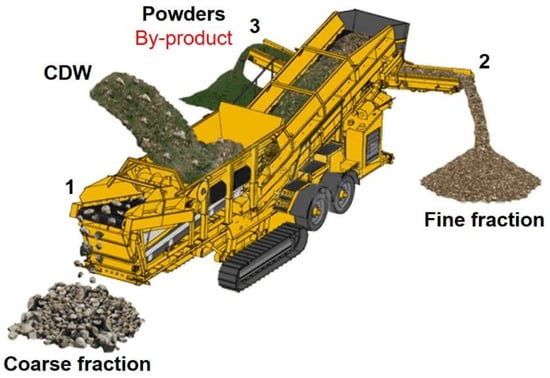
Figure 1.
Construction and demolition waste (CDW) transformation and grinding process: coarse 1, fine 2 and powder 3 fractions.
In relation to the above, alkaline activation or geopolymerization is a technique used for the synthesis of cementitious materials from the physical–chemical interaction of aluminosilicate materials (geopolymeric precursor) and highly alkaline solutions (activators) [13]. Incidentally, the use of alkaline activation technology as an alternative for the use of CDW has been growing in recent years (Figure 2). As reported in Table 1, the results related to the alkaline activation of CDW are promising and demonstrate the potential of this type of waste to be reused by this technology.
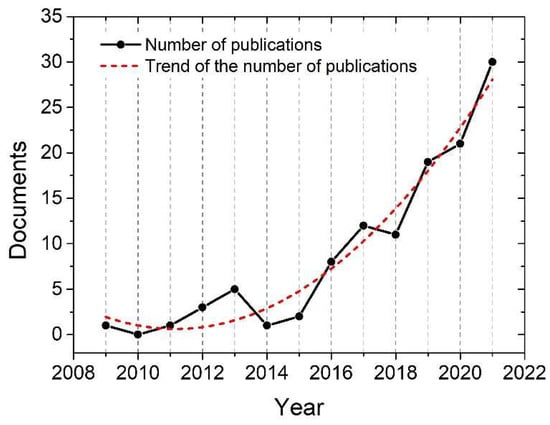
Figure 2.
Evolution of the number of publications related to the alkaline activation or geopolymerization of CDW. Source: Scopus Elsevier database. Search: TITLE-ABS-KEY (construction AND demolition AND wastes) AND TITLE-ABS-KEY (alkali-activated AND material) OR TITLE-ABS-KEY (geopolymer). Total publications (between 2009 and 2022): 133 documents.

Table 1.
Main antecedents related to the alkaline activation of CDW.
As seen in Table 1, most studies focus on the use of separated (“clean”) waste. However, the separation of CDW is, in most cases, unfeasible from technological and economic points of view. Therefore, evaluating the use of mixed or combined waste becomes more attractive.
Regarding the above, Tan et al. [36] reported strengths of up to 29.7 MPa for alkali-activated cements (NaOH + Na2SiO3) based on CDW-Mixed and concluded that the mechanical strength depends on the reactivity and chemical composition of the constituent materials. In effect, to achieve these strengths, the pastes were cured at 50 °C for 7 days (limiting for in situ applications). In this regard, Moreno-Maroto et al. [35] reported percentages of reactivity (amorphous phase) of CDW-Mixed between 16 and 27%, with low Al2O3 contents (4–6%), requiring the application of curing processes at 90 °C for 24 h to achieve better mechanical performances (11–15 MPa) via alkaline activation (NaOH + Na2SiO3). As a solution to this limitation, the incorporation of supplementary cementitious materials or additions rich in calcium has demonstrated advantages from a technological point of view, since it allows greater mechanical performance to be achieved at room temperature (25 °C); that is, it does not employ hydrothermal curing treatments (50–90 °C). In this regard, in a previous study [10], the possibility of using mixtures of Co + Ce + M (CDW-Mixed) in the synthesis of alkali-activated hybrid cements (NaOH + Na2SiO3) with only 10% ordinary Portland cement (OPC) was demonstrated; compressive strengths of up to 32.2 MPa were reached after 90 days of curing at room temperature (25 °C). In contrast, Şahin et al. [31] reported that the addition of 10% Ca(OH)2 during the alkaline activation process of CDW-Mixed promotes better rheological and mechanical behavior. Regarding the use of alternative solid activators, such as sodium sulfate or sodium carbonate, in the alkaline activation of CDW-Mixed, it has been reported that doses of 2–6% (Na2SO4) and 5–10% (Na2CO3) promote mechanical strengths of up to 31 MPa and 22 MPa, respectively [27].
For the implementation of these advances in the construction sector, it is necessary to validate the use of alkali-activated CDW-Mixed in the production of construction materials (applications). As evidenced in Table 1, most publications report results only at the level of pastes, which limits the technological transfer of these results to the industry. In this sense, this study aims at the integral use of the coarse 1, fine 2 and powder 3 (Figure 1) fractions from CDW-Mixed (Co + Ce + M) in the production of alkali-activated materials, such as cements, mortars, concretes, fiber-reinforced materials and prefabricated units, such as solid blocks, perforated (hollow) blocks and pavers.
2. Materials and Methods
The CDW used in this research was composed of Co, Ce and M collected in a final disposal site located in the city of Cali (Colombia). The waste was subjected to a crushing process (Figure 3) in a local plant with a 1 ton/day capacity (MAECOL SAS). From this transformation process, particulate materials were obtained with maximum sizes of 25.4 mm (1 in.), 19.1 mm (3/4 in.), 4.76 mm (No. 4) and 1.19 mm (No. 16) that were suitable for use as recycled aggregates (coarse and fine). Additionally, in each crushing process (Co, Ce and M), powder-type by-products were collected and subsequently used as precursors for an alkali-activated hybrid cement (geopolymer), following the experience of a previous study [10]. Applying this technology (alkaline activation) in this research, the comprehensive use of all products and by-products generated during the crushing of CDW in the production of cements, mortars, concretes and construction applications (prefabricated elements) was achieved.
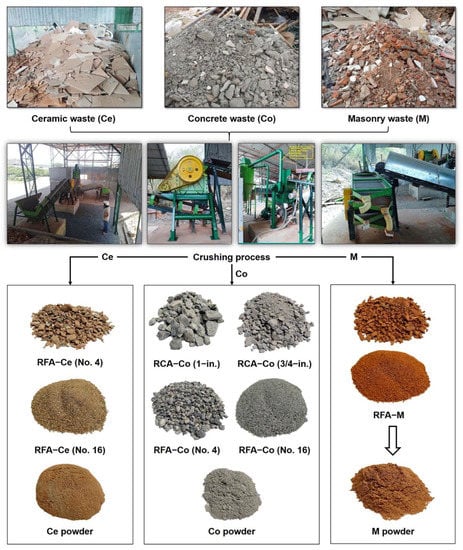
Figure 3.
Diagram of the transformation process of concrete (Co), ceramic (Ce) and masonry (M) waste, obtaining coarse, fine and powder fractions.
2.1. Alkali-Activated Hybrid Cement
The hybrid cement was obtained from the alkaline activation of a precursor composed of CDW-Mixed with the addition of 10% UG-type OPC (% by weight). Ninety percent of the hybrid cement corresponding to the geopolymer precursor (CDW-Mixed) was composed of 30% Co powder + 30% Ce powder + 30% M powder (90% total). As shown in Figure 3, these powders were by-products collected from the crushing process of Co, Ce and M. The CDW powders have a fine size that did not allow them to be reused as aggregates in mortar and concrete mixtures according to the specifications of the ASTM C33 standard [9]. The average particle size of CDW-Mixed was 57.6 µm. The value reported for the OPC used as an addition (10%) was 21.3 µm. The chemical composition (X-ray fluorescence (XRF)) of CDW-Mixed consisted mainly of SiO2 (51.5%), CaO (14.6%), Al2O3 (14.3%), Fe2O3 (6.7%) and other materials (5.3%), with a loss on ignition (LOI) of 7.6%. As an alkaline activator (AA), a mixture of sodium hydroxide (NaOH) (industrial grade) and sodium silicate (waterglass) (Na2SiO3) (SiO2 = 32.1%, Na2O = 11.9%, H 2 O = 56.0%) (industrial grade) was used. For the preparation of the AA, a ratio (by weight) of NaOH/Na2SiO3 of 0.25 was set, equivalent to a modulus of SiO2/Na2O solution (molar) of 1. The content of AA used in mixtures varied by 0.2, 0.3 and 0.4, where these values are equivalent to the ratio (by weight) AA/(precursor + OPC). The compressive strength of the alkali-activated hybrid cement can be observed in Figure 4. The cement reached strengths of 22.6 MPa at 28 days of curing at room temperature (≈25 °C) and 32.2 MPa at 90 days. A detailed description of the synthesis and characterization of the hybrid cement used can be found in a previous study [10].
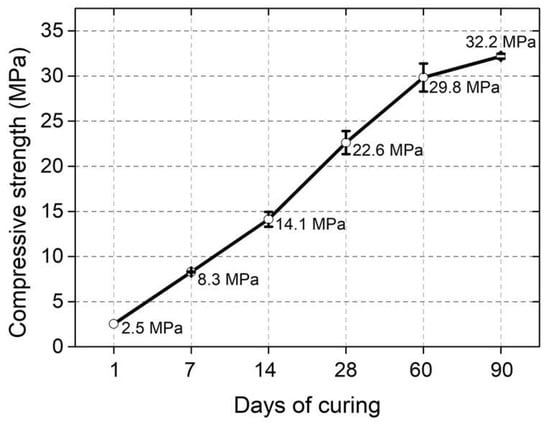
Figure 4.
Compressive strength of alkali-activated hybrid cement based on CDW-Mixed (30% Co powder + 30% Ce powder + 30% M powder) with the addition of 10% OPC.
2.2. Recycled Aggregates
The recycled fine aggregate (RFA) was obtained from the combination of RFA—Ce (No. 4), RFA—Co (No. 4), RFA—Ce (No. 16) and RFA—Co (No. 16) (Figure 3) in proportions of 20, 20, 30 and 30% (by weight), respectively. From this combination, compliance with the gradation limits established by the ASTM C33 standard was achieved [9] for fine aggregates (sands) (Figure 5). The recycled coarse aggregate (RCA) was obtained from the combination of RCA—Co (1 in.) and RCA—Co (3/4 in.) at 85 and 15% (by weight), respectively. The ideal gradation of the recycled aggregates (RFA and RCA) for the concrete mixtures was obtained from the Fuller–Thompson theory [37] and corresponded to a combination of RFA and RCA of 30 and 70% (by weight), respectively (Figure 5).
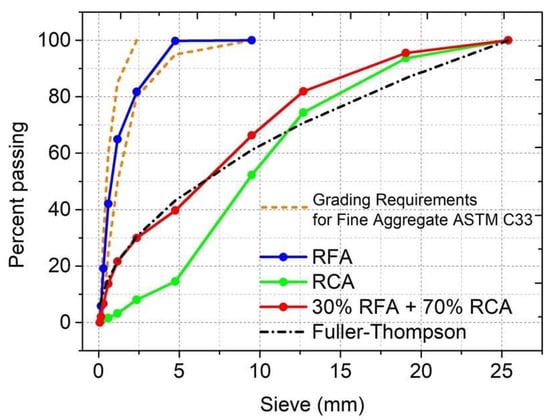
Figure 5.
Particle size curves and ideal combination (Fuller–Thompson) of fine and coarse recycled aggregates (RFA and RCA).
Table 2 presents the physical–mechanical characterization of the recycled aggregates. The absorption percentage (5.82%) and the wear coefficient (28.2%) reported for the RCA are highlighted; these values are below the maximum allowed by the NTC 6421 standard [38]. This supports its use in structural concrete mixtures (f′c ≥ 17.5 MPa). In general, the characterization results for the recycled aggregates meet the requirements established by the ASTM C33 standard [9].

Table 2.
Physical–mechanical characterization of the recycled aggregates (RFA and RCA).
2.3. Design and Production of Mixtures (Mortars and Concretes)
From the alkali-activated hybrid cement and the incorporation of RFA and RCA, mixtures of mortars and concretes were designed and characterized. The mortars were produced in a Hobart mixer, and a CreteAngle horizontal mixer was used to produce the concretes. In both cases, a total mixing time of 5 min was set. The curing of mortars and concretes was performed at room temperature (25 °C). Table 3 presents the dosage (kg/m3) of the alkali-activated mortars, highlighting the variation in the AA content between 0.2 and 0.4 and the content of RFA in cement:aggregate ratios of 1:1 and 1:2. Table 4 shows the design (kg/m3) of fiber-reinforced mortars based on the AA0.4—RFA1:1 mortar and the incorporation of short polypropylene (PP) fibers (SikaFiber AD synthetic fiber (fiber length = 19 mm)) in quantities of 0, 0.4 and 0.8% by weight, according to the technical recommendations for the product. The fibers were introduced in the last stage of mixing and their orientation was randomly dispersed.

Table 3.
Dosage (kg/m3) of alkali-activated mortars produced from hybrid cement (cured at 25 °C).

Table 4.
Dosage (kg/m3) of the fiber-reinforced mortars produced from the AA0.4—RFA1:1 mortar (cured at 25 °C).
In the case of the alkali-activated concretes obtained from the hybrid cement (AA 0.4) and the combination of RFA and RCA, the effects of cement contents of 450, 550 and 650 kg/m3 were evaluated, as seen in Table 5. It is noteworthy that the total content of CDW (the sum of the RCA, RFA and powder (Co, Ce and M) fractions) present in the concretes varied between 80 and 86% of the total weight of the mixtures (2247 kg/m3), a range that represents a high level of utilization of the CDW.

Table 5.
Dosage (kg/m3) of alkali-activated concrete obtained from hybrid cement (AA 0.4) and recycled aggregates (RFA and RCA) (cured at 25 °C).
From the 550 kg/m3 concrete mixture (Table 5), fiber-reinforced concretes were designed with the incorporation of PP macrofibers (SikaFiber 600; fiber length = 52 mm) in quantities of 0, 0.4 and 0.8% by weight (Table 6), according to the technical recommendations for the product. The fibers were introduced in the last stage of mixing and their orientation was randomly dispersed.

Table 6.
Dosage (kg/m3) of fiber-reinforced concrete produced from hybrid cement (AA 0.4) and recycled aggregates (RFA and RCA) (cured at 25 °C).
2.4. Analysis of the Environmental Impact Associated with Raw Materials
To evaluate the environmental impact of alkali-activated hybrid concretes based on high contents (80–86%) of CDW, a preliminary life cycle analysis (LCA) was performed that included the calculation of the global warming potential (GWP) or “carbon footprint” associated with the raw materials. The LCA was carried out according to ISO 14040 [39]. For the analysis of the emissions inventory (kg CO2 eq), the Ecoinvent 3.6 database was used [40], and to evaluate the environmental impact of the concrete mixtures, the Basal CML 2001 methodology was used. The LCA employed a “cradle-to-gate” approach. The functional unit of the LCA was 1 m3 of concrete, taking as reference the mixture designs (450, 550 and 650) that were reported in Table 5. For comparative purposes, the GWP results obtained for the alkali-activated hybrid concretes were contrasted with concrete mixtures based on 100% OPC (reference) with cement contents equivalent to 450, 550 and 650 kg/m3 concrete.
2.5. Precast Concrete Elements
To validate the application potential of alkali-activated materials based on CDW in the construction sector, prefabricated elements, such as solid blocks, perforated (hollow) blocks and pavers, were produced from the 550 kg/m3 concrete mixture (Table 5). The prefabricated elements were produced by casting the concrete mixture. The two types of concrete blocks produced according to the NTC 4026 standard [41] corresponded to (1) solid load-bearing units 200 mm long × 100 mm wide × 80 mm high and (2) vertically perforated (hollow) units 400 mm long × 120 mm wide (wall thickness of 25 mm) × 200 mm in height. The concrete paver produced was “type 2 with I-shape”, according to the classification established by the NTC 2017 standard [42]. The paver was an inscribed rectangle 200 mm in length and 90 mm in width, with a height of 100 mm.
2.6. Experimental Tests
2.6.1. Mortars
The alkali-activated mortars were characterized through compressive strength tests, according to the specifications established in the ASTM C109 standard [43]; in the case of fiber-reinforced mortars, flexural strength was determined using the procedure described in the ASTM C348 standard [44]. These tests were realized at 7, 28 and 90 days of curing (25 °C).
2.6.2. Concretes
The alkali-activated concretes were characterized through compressive strength tests according to the ASTM C39 standard [45]; flexural strength was determined according to the ASTM C293 standard [46]; density, water absorption and porosity were determined according to the ASTM C642 standard [47]; and capillary suction (sorptivity) was determined according to the ASTM C1585 standard [48]. The mechanical and physical tests were realized at 7, 28 and 90 days of curing (25 °C). Additionally, scanning electron microscopy (SEM) analysis at 28 days of curing (25 °C) was performed. SEM was performed on a JEOL JSM-6490LV microscope with an accelerating voltage of 20 kV. The specimens were examined in low vacuum (low vacuum mode). An Oxford Instruments INCAPentaFETx3 X-ray spectrometer (EDS) was attached to the microscope. The inspection was carried out on concrete samples of 1 cm3 which were obtained by cutting 3″ diameter cylinders and later encapsulated in epoxy resin to polish the observation surfaces.
2.6.3. Prefabricated Concrete Elements
The concrete blocks (solid and perforated) were characterized according to the specifications established in the NTC 4026 standard [41]. The tests included the determination of compressive strength, density and water absorption at 28 days of curing (25 °C). The compression test for the blocks was carried out in a Controls Model CT-1500 hydraulic press with a capacity of 1500 KN. The concrete pavers were characterized by flexotraction tests (modulus of rupture), density and water absorption at 28 days of curing (25 °C), according to the NTC 2017 standard [42]. The flexotraction test for the pavers was carried out in a Tinius Olsen Model H50KS universal testing machine with a 50 KN compression capacity.
3. Results and Analysis
3.1. Mechanical Characterization of the Activated Alkali Mortars
The effect of the contents of AA (0.2–0.4) and RFA (cement:aggregate ratio of 1:1 and 1:2) on the compressive strength of alkali-activated mortars can be observed in Figure 6. In general, the content of AA (NaOH + Na2SiO3) favors the development of the mechanical strength of the mortars. At 28 days of curing (25 °C), the compressive strengths of the AA 0.2, AA 0.3 and AA 0.4 mortars with RFA contents of 1:1 were 11.3 MPa, 23.4 MPa and 30.9 MPa, respectively. On the other hand, in the case of RFA contents of 1:2, the strengths were 5.4 MPa, 5.5 MPa and 13.2 MPa, respectively. In reference to the above, a higher content of AA (NaOH + Na2SiO3) increases soluble silica species (–Si–O–) and provides the necessary conditions for geopolymerization reactions (alkaline activation) [14]. Similarly, sodium silicate (Na2SiO3) favors the union (adherence) of the precursor particles that do not react (anhydrous), thus increasing the resistance of alkali-activated materials based on low reactivity aluminosilicates, such as CDW powders (concrete, ceramic and masonry waste) [10].
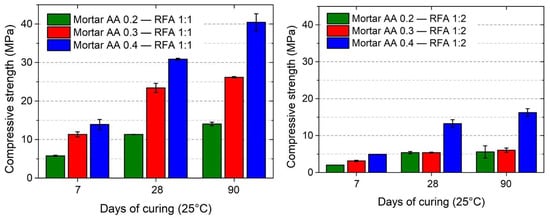
Figure 6.
Compressive strength of alkali-activated mortars based on hybrid cement (cured at 25 °C): effect of alkaline activator content (AA 0.2, 0.3 and 0.4) and recycled fine aggregate (RFA 1:1 and 1:2).
With respect to the performance reported at 90 days of curing, an increase in mechanical strength was observed compared to that at 28 days. The higher the AA content (AA 0.4 > AA 0.3 > AA 0.2), the lower the RFA content. In effect, the increases in strength (at 90 days vs. 28 days) for the AA 0.4 RFA 1:1 and AA 0.4 RFA 1:2 mortars were 40.0% and 22.6%, respectively. It should be noted that the evolution of the compressive strength of the alkali-activated mortars agrees with the behavior shown by the hybrid cement, which is presented in Figure 4. The effect of higher RFA content (cement:aggregate ratio) on the compressive strength of the mixtures is the opposite of the effect shown by the AA. For example, if we compare the strengths reported for the AA 0.4 RFA 1:1 mortar at 7, 28 and 90 days, which were 13.9 MPa, 30.9 MPa and 40.5 MPa, respectively, with those obtained for the AA 0.4 mortar with RFA 1:2 (4.9 MPa, 13.2 MPa, 16.2 MPa), drops in strength between 57 and 65% were observed. In this regard, a higher cement:aggregate ratio decreases the content of paste per unit volume of mortar and increases the interfacial transition zones (ITZs). It should be added that the strength of ITZs, as well as binding and adhering power, notably influence the properties and mechanical behavior of alkali-activated materials with recycled aggregates [49].
The bending behavior of the fiber-reinforced mortars based on the AA 0.4 RFA 1:1 mixture and the incorporation of short PP fibers (SikaFiber AD synthetic fiber) in quantities of 0, 0.4 and 0.8% (by weight) can be observed in Figure 7.
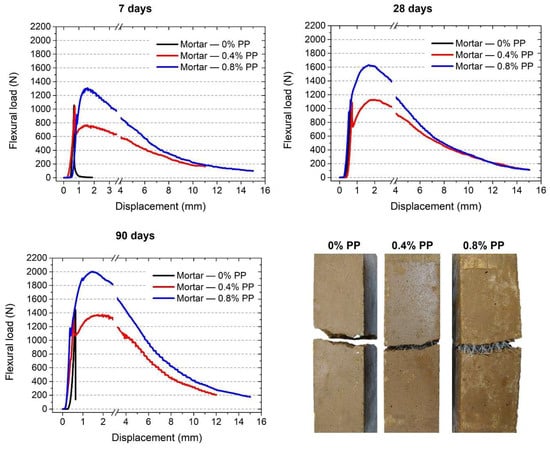
Figure 7.
Load–displacement curves of the fiber-reinforced mortars produced from the AA0.4—RFA1:1 mortar (cured at 25 °C): effect of the content of polypropylene (PP) fibers (SikaFiber AD) (0, 0.4 and 0.8% by weight/m3 of mortar).
In general, the load vs. displacement shows an increase in the maximum breaking load proportional to the fiber content in the mixture (0.8% PP > 0.4% PP > 0% PP) and the curing age (90 days > 28 days > 7 days). Similarly, the post-fracture benefit of the fibers in relation to flexural–tensile stresses increases; that is, increases in the post-cracking toughness and ductility of the mortars are promoted by a type of gradual failure governed by pull-out (progressive pull-out) of the fibers [50]. This phenomenon can be corroborated by the photographs of the failure modes recorded in Figure 7, where the “bridging” of the cracks by the fibers is evident, which is greater with increasing fiber content. As observed in the graphs, a fiber content of 0.8% in the fiber-reinforced mortars caused the phenomenon of deformation hardening; that is, it increased the capacity to support loads even when the matrix exceeded the resistance to the first crack.
The modulus of rupture associated with fiber-reinforced mortars are presented in Figure 8. In this case, a notable increase in flexural strength can be observed when the fiber content is 0.8%, in accordance with the behavior shown by this same mixture in the load vs. displacement analysis (Figure 7). In contrast, a lower fiber content (0.4% PP) does not increase this property. At 28 days of curing, the 0% PP, 0.4% PP and 0.8% PP mortars have modulus of rupture of 3.16 MPa, 3.17 MPa and 4.58 MPa, respectively. These values represent an increase of 44.9% in the flexural strength of the fiber-reinforced mortar with 0.8% fiber in relation to that of the reference mixture (without fiber).
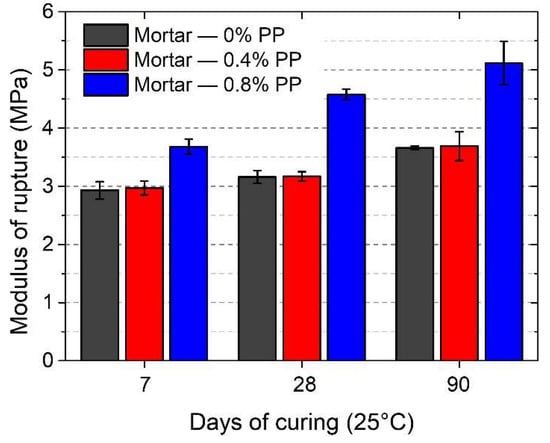
Figure 8.
Flexural modulus of rupture of fiber-reinforced mortars produced from AA0.4—RFA1:1 mortar (cured at 25 °C): effect of polypropylene (PP) fiber.
3.2. Physical–Mechanical and Microstructural Characterization of Alkali-Activated Concretes
Figure 9 presents the compressive strength results obtained at the concrete level, highlighting the effect of the hybrid cement contents of 450 kg/m3, 550 kg/m3 and 650 kg/m3. In general, the results obtained show that a higher content of hybrid cement increases the compressive strength of alkali-activated concretes. In fact, the maximum mechanical strengths were obtained for the 650 kg/m3 mixture, with values of 7.3 MPa, 13.9 MPa, 28.0 MPa and 36.9 MPa reached at 3, 7, 28 and 90 days of curing, respectively. According to the Colombian Earthquake Resistant Standard (NSR-10) [51], equivalent to ACI Regulation 318 [52], the minimum compressive strength to classify a concrete as structural is 17.5 MPa. In this sense, the 550 kg/m3 (21.1 MPa) and 650 kg/m3 (28.0 MPa) concretes meet the minimum strength necessary to be classified as structural at 28 days of curing. It should be noted that if a longer curing age is taken into account (90 days), all the mixtures, including the 450 kg/m3 concrete, exceed the limit established by the NSR-10. The strength values at 90 days of curing of the 450 kg/m3, 550 kg/m3 and 650 kg/m3 concretes were 21.4 MPa, 28.1 MPa and 36.9 MPa, respectively. On the other hand, it should be noted that the increase in compressive strength between 3 and 90 days of curing for these mixtures was between 408% and 544%, which demonstrates the importance of guaranteeing an adequate curing process. In this regard, as mentioned in the methodology (Section 2.3), the curing of the concrete mixtures was performed at room temperature (25 °C) and at a relative humidity greater than 80%. The graphs of the evolution of strength show a marked tendency for increased mechanical performance at greater ages (i.e., greater than 90 days).
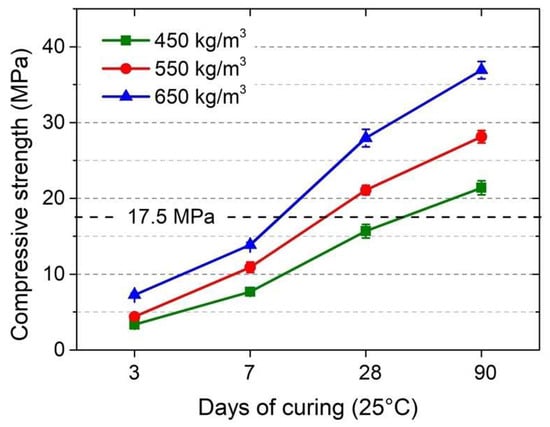
Figure 9.
Compressive strength of alkali-activated concrete based on hybrid cement (AA 0.4) and recycled aggregates (RFA and RCA) (cured at 25 °C): effect of cement content (450, 550 and 650 kg/m3).
The results obtained demonstrate the possibility of designing and producing concretes with high CDW contents, taking into account that both the hybrid cement and the recycled aggregates (fine and coarse) are based on the use of Co, Ce and M. In this regard, in Colombia, Resolution 1257 of 2021 of the Ministry of the Environment “By which the integral management of waste generated in construction and demolition activities—RCD is regulated” establishes that the goal for CDW use will be up to 75% by 2030 [53]. This represents a challenge for the construction sector in terms of the search for alternatives that will allow the reuse of the various usable materials (concrete, ceramics, masonry, etc.) that make up CDW, even in scenarios where their separation is not possible (mixed residues). Recently, the Colombian Technical Standard NTC 6421 [38] has endorsed the use of RCA in concrete mixtures as follows: for structural uses (max. 35 MPa), the incorporation of 20% RCA is allowed, and for non-structural uses (max. 21 MPa), 100% RCA is allowed. Despite these limits, the results obtained in this study demonstrate the possibility of achieving structural strengths (>17.5 MPa) not only with the incorporation of 100% RCA but also 100% RFA and an activated alkali-based hybrid cement (90%) based on CDW-Mixed.
In Figure 10, the load–displacement curves for the fiber-reinforced concretes produced from the hybrid cement and mixed recycled aggregates (RFA and RCA) are presented. It should be noted that these mixtures were based on the incorporation of PP macrofibers (SikaFiber 600) in quantities of 0%, 0.4% and 0.8% (by weight) in the 550 kg/m3 concrete. In accordance with the behavior reported for the fiber-reinforced mortars, the incorporation of the PP fibers promoted performance against flexural–tensile stresses. In Figure 10, it can be observed that the fibers were responsible for a slight increase in the resistance to the first crack proportional to the amount of reinforcement incorporated (0.8% PP > 0.4% PP > 0% PP). As cited in [54], this can be attributed to a reduction in the appearance of microcracks caused by the phenomena of plastic contraction and to the redistribution of stresses during the elastic zone. In the case of mixtures without fibers (pattern), there is a first phase of the practically elastic load–displacement curve, followed by microcracking of the matrix that quickly leads to the brittle failure of the material (Figure 10). On the other hand, in the fiber-reinforced concretes (0.4% PP and 0.8% PP), better post-fracture behavior was observed, that is, a greater capacity of the material to support loads up to higher values of deformation. As in the mortars, this positive effect was promoted by the phenomenon of “bridging”, that is, the progressive pull-out of the fibers on both sides of the crack [50]. As seen in Figure 10, the failure mode of the fiber-reinforced concretes (0.4% PP and 0.8% PP) shows that the “bridging” action of the fibers prevents the brittle failure of the concrete matrix and contributes to obtaining greater ductility and toughness. In the presence of fibers, the initiation and propagation of microcracks is reduced due to the redistribution of stresses and the greater fracture energy necessary to extract the fibers from both faces of the crack post-fracture [55]. This reinforcing action depends largely on the fiber–matrix interaction and the stiffness, dispersion and content of incorporated fibers.
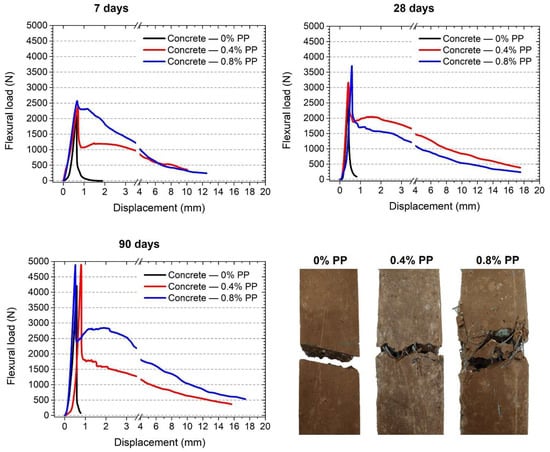
Figure 10.
Load–displacement curves of fiber-reinforced concrete produced from hybrid cement (AA 0.4) and recycled aggregates (RFA and RCA) (cured at 25 °C): effect of polypropylene (PP) macrofiber content (SikaFiber 600) (0, 0.4 and 0.8% by weight/m3 of concrete).
Regarding the modulus of rupture for the concretes, calculated from maximum bending load, a positive effect can be observed, promoted by the fiber content and the curing age, in accordance with the development of compressive strength shown above (Figure 11). In effect, the modulus of rupture of the concretes 0% PP, 0.4% PP and 0.8% PP at 28 days of curing were 2.3 MPa, 2.7 MPa and 3.3 MPa, respectively. If the flexural strengths (28 days) of the 0.4% PP and 0.8% PP concretes are compared with the reference mixture (without fibers), increases promoted by the incorporation of the fibers of 18.2% and 45.3% are evident, respectively. Regarding the evolution of the flexural strength as a function of curing age, the 0.8% PP mixture showed modulus of rupture of 3.4 MPa, 3.7 MPa and 4.0 MPa at 7, 28 and 90 days of curing, respectively. On the other hand, compared with the values for compressive strength reported for the 550 kg/m3 concrete (matrix) at 7 days (10.9 MPa), 28 days (21.1 MPa) and 90 days (28.1 MPa), the modulus of rupture previously reported for the 0.8% PP concrete represent between 14.2% and 31.2% of the compressive strength achieved.
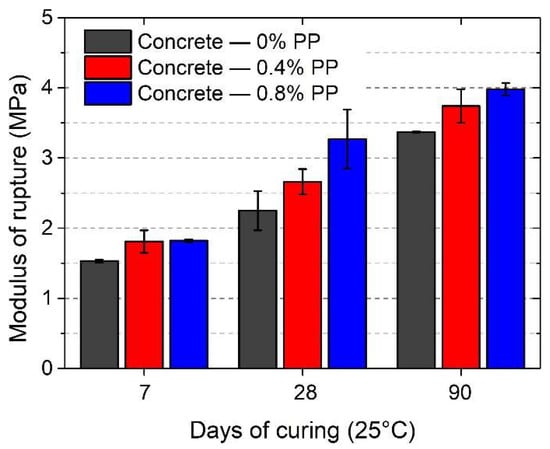
Figure 11.
Flexural modulus of rupture of fiber-reinforced concrete produced from hybrid cement (AA 0.4) and recycled aggregates (RFA and RCA) (cured at 25 °C): effect of polypropylene (PP) macrofiber content (SikaFiber 600) (0, 0.4 and 0.8% by weight/m3 of concrete).
In addition to the mechanical characterization, the physical properties of the alkali-activated concretes were determined, such as density, absorption and porosity. Similarly, the capillary water absorption rate (sorptivity) was studied at 28 and 90 days of curing. In Table 7, the density, absorption and porosity results are presented. In agreement with the results for compressive strength (Figure 9), it can be observed that a higher content of hybrid cement promotes a slight densification of the concretes and at the same time a decrease in the absorption and porosity of the mixtures. With reference to the above, 650 kg/m3 concrete was 4.1% denser at 28 days than concrete with a lower cement content (450 kg/m3). Similarly, decreases in absorption of −17.2% and porosity of −10.5% can be observed when comparing the 650 kg/m3 and 450 kg/m3 concretes. This behavior could be related to the fact that a higher cement content decreases the volume of aggregates present in the mixture (Table 5). As presented in Table 2, the RFA and RCA have absorption capacities of 8.96% and 5.82%, respectively. In effect, a lower content of recycled aggregates (RFA and RCA) in turn decreases the porosity and absorption of the mixtures.

Table 7.
Physical characterization of alkali-activated hybrid concretes: density, absorption, and porosity tests.
The density, absorption and porosity results are in agreement with those obtained in the capillary suction test (sorptivity). From Figure 12, it is evident that the capillary water absorption (I, mm) of the concretes is inversely proportional to the content of hybrid cement. In this sense, the higher the cement content, the lower the sorptivity of the mixtures, that is, their maximum level of saturation by capillarity decreases.
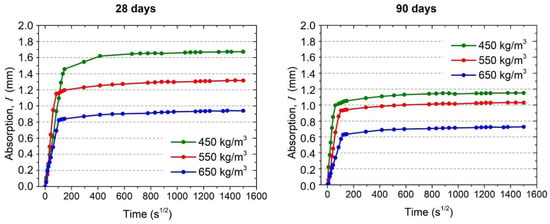
Figure 12.
Capillary water absorption rate (sorptivity) of alkali-activated hybrid concretes.
At 28 days, the maximum capillary absorption values (reached at 1500 s1/2) of the 450 kg/m3, 550 kg/m3 and 650 kg/m3 concretes were 1.67 mm, 1.32 mm and 0.94 mm, respectively. On the other hand, a longer curing age (90 days) was associated with a decrease in the sorptivity of the concretes, with maximum capillary absorption values (1500 s1/2) of 1.15 mm, 1.03 mm and 0.73 mm for the 450, 550 and 650 kg/m3 concretes, respectively. This behavior is related to the decrease in the total and interconnected porosities as a function of curing age, as can be corroborated in Table 7.
In Figure 13, scanning electron microscopy (SEM) images (×100) obtained for the alkali-activated hybrid concretes (450 kg/m3, 550 kg/m3 and 650 kg/m3) can be observed.
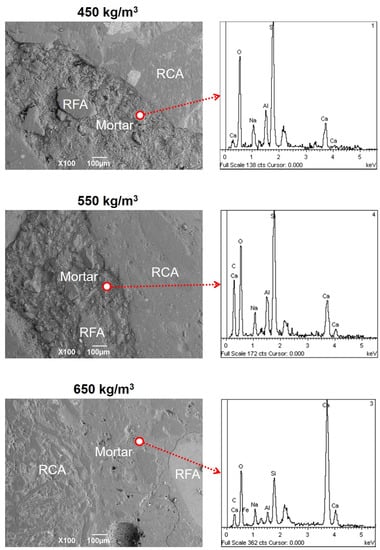
Figure 13.
Microstructural analysis (SEM-EDS) of alkali-activated hybrid concretes.
In general, it is possible to identify densification of the microstructures of matrixes as the content of hybrid cement increases. This finding is in agreement with the results obtained at the physical level (for density, absorption and porosity (Table 7) and for sorptivity (Figure 12)) and at the mechanical level (compressive strength (Figure 9)). From the elemental composition analysis (energy-dispersive spectroscopy (EDS)) performed on the alkali-activated concretes, it was possible to corroborate that the matrix was composed mainly of silica (Si), alumina (Al), calcium (Ca) and sodium (Na), in accordance with the chemical composition of the hybrid cement based on the mixture of CDW-Mixed (90%) and the addition (10%) of OPC and AA (Na2SiO3 + NaOH). As demonstrated in a previous study [10], the microstructural analysis of this hybrid cement shows that its chemical composition (SiO2–Al2O3–CaO–NaO) is grouped in regions representative of CASH-type calcium-rich gels and gels of intermediate composition type (N,C)-ASH, the product of the interaction over time of NASH and CSH-type primary gels, which agrees with the mechanical performance values obtained in this research (Figure 9).
3.3. Analysis of the Environmental Impact Associated with Raw Materials
The inventory of emissions or the “carbon footprint” associated with the alkali-activated hybrid concretes (450, 550 and 650 kg/m3) can be observed in Table 8. Indeed, the global warming potential (GWP) of the raw materials demonstrates the low carbon footprint of the CDW precursor (≈3.80 × 10−3 kg∙CO2∙eq/kg) in relation to that of the OPC (≈8.45 × 10−1 kg∙CO2∙eq/kg), which promotes the use of CDW in a circular economy geared towards “zero waste”. Despite this environmental advantage, the use of traditional alkaline activators, such as sodium hydroxide (NaOH) and sodium silicate (Na2SiO3), in the synthesis of alkaline-activated materials must be considered due to their high carbon footprint.

Table 8.
Emissions inventory (GWP: kg∙CO2∙eq) of the raw materials used in the production of 1 m3 of alkali-activated hybrid concrete. Effect of precursor content (450, 550 and 650 kg/m3). Data source: Ecoinvent 3.6.
As can be seen in Table 8, the carbon footprint of NaOH is ≈1.46 kg∙CO2∙eq/kg and ≈8.12 × 10−1 kg∙CO2∙eq/kg in the case of Na2SiO3. Thus, as mentioned by Alsalman et al. [56], the GWP of an alkali-activated concrete depends directly on the proportioning or design of mixtures; that is, a higher content of AA translates into a higher GWP value. In effect, the carbon footprint values for the alkali-activated hybrid 450, 550 and 650 kg/m3 concretes were 215.2, 261.0 and 306.8 kg∙CO2∙eq/m3 of concrete, respectively. For comparative purposes, the GWP results for the alkali-activated hybrid concretes were contrasted with reference mixtures based on OPC contents equivalent to 450, 550 and 650 kg/m3 concrete. The GWP values for the OPC concretes were 386.4, 470.3 and 554.2 kg∙CO2∙eq/m3 of concrete, respectively. In effect, this analysis showed that alkali-activated concretes with hybrid cement contents of 450, 550 and 650 kg/m3 have a carbon footprint that is 44% lower than that of reference concretes based on 100% OPC, which classifies them as environmentally friendly as compared with conventional concretes. As mentioned by Valencia-Saavedra et al. [27] and Villaquirán-Caicedo and Mejía de Gutiérrez [33], the use of alternative solid activators, such as sodium sulfate (Na2SO4) or sodium carbonate (Na2CO3), would further reduce the carbon footprint of this type of material, increasing the environmental advantage of the reuse of CDW-Mixed in the obtainment of hybrid cements with OPC contents of less than 30% by weight with respect to the geopolymeric precursor.
3.4. Physical–Mechanical Characterization of Construction Applications (Prefabricated Elements)
From the 550 kg/m3 concrete mixture (Table 5), constructive applications (prefabricated elements) of the solid block type (NTC 4026 [41]), perforated (hollow) blocks (NTC 4026 [41]) and “type 2 I-shaped” pavers (NTC 2017 [42]) were manufactured (Figure 14).

Figure 14.
Construction applications (prefabricated elements) of the solid block type (NTC 4026), perforated (hollow) blocks (NTC 4026) and “type 2 I-shaped” pavers (NTC 2017), produced from alkali-activated hybrid concrete.
Table 9 presents the results for the physical–mechanical characterization of the precast units. According to the requirements of compressive strength and water absorption (according to weight) established by NTC 4026 [41] for concrete units in structural masonry, both the solid block and the perforated (hollow) block can be classified as “high-class structural blocks”. Indeed, NTC 4026 [41] establishes a minimum value of compressive strength of 13 MPa and a maximum percentage of water absorption of 12% for medium-weight units (1680–2000 kg/m3). In relation to the above, the solid block had a strength (28 days) of 22.6 MPa and an absorption of 11.6%. The perforated (hollow) blocks had 19.8 MPa and 11.3% compressive strength and water absorption, respectively. It is worth mentioning that the densities of the blocks were 1938 kg/m3 (solid block) and 1951 kg/m3 (perforated block).

Table 9.
Physical–mechanical characterization of construction applications (prefabricated elements).
According to these results and the specifications established by the NSR-10 [51], both blocks can be used for the construction of earthquake-resistant houses of one or two floors in Colombia. In the case of pavers, NTC 2017 [42] establishes that the specimens should have a water absorption not exceeding 7% and a flexural strength or modulus of rupture at 28 days of minimum 4.2 MPa. From the results reported for the paver (Table 9), it can be concluded that it does not meet the water absorption requirements (10.1%); however, it reaches the minimum compressive strength (4.2 MPa) required by the standard. Incidentally, the absorption values for the blocks and pavers agree with those reported for the alkali-activated 550 kg/m3 concrete (Table 7) used in the production of these prefabricated elements. The presence of high contents (100%) of recycled aggregates (RCA and RFA) is considered to be the reason for the high values of porosity and absorption [12].
The prefabricated units produced in this study are proposed as alternatives for the construction sector in Colombia. The use of high CDW contents in the production of construction materials could contribute to the fulfilment of the requirements established by the Ministry of the Environment through Resolution 1257 of 2021 [53], which requires construction companies to recycle 75% (as the target for 2030) of the CDW generated on site.
4. Conclusions
This study demonstrated the possibility of achieving an integral use (recycling) of the coarse and fine fractions and powders from CDW-Mixed (Co + Ce + M) through alkaline activation technology. To bring the implementation (technology transfer) of these advances in the construction sector closer, the use of alkali-activated CDW-Mixed was validated in the production of cements, mortars, concretes, fiber-reinforced materials and prefabricated units, such as solid blocks, perforated (hollow) blocks and pavers. From the results obtained, the following conclusions can be drawn:
At the level of mortars, the content of AA (NaOH + Na2SiO3) favored the development of mechanical strength (AA 0.4 > AA 0.3 > AA 0.2). Similarly, it was shown that a lower cement:aggregate ratio (RFA) allows greater strength to be achieved. In this sense, the highest compressive strengths were those reported for the AA 0.4 RFA 1:1 mortar, which were 13.9 MPa, 30.9 MPa and 40.5 MPa at 7, 28 and 90 days, respectively. Regarding the effect of the incorporation of PP fibers, the results showed an increase in the maximum breaking load proportional to the content of PP fiber in the mixture (0.8% PP > 0.4% PP > 0% PP). In effect, the mortars with 0% PP, 0.4% PP and 0.8% PP reported a modulus of rupture (28 days) of 3.16 MPa, 3.17 MPa and 4.58 MPa, respectively.
At the level of concretes, a higher content of hybrid cement (650 kg/m3 > 550 kg/m3 > 450 kg/m3) promoted a gain in compressive strength in the alkali-activated concretes. The maximum mechanical strengths were reported for the 650 kg/m3 mixture, reaching values of 7.3 MPa, 13.9 MPa, 28.0 MPa and 36.9 MPa at 3, 7, 28 and 90 days of curing, respectively. The incorporation of PP fibers generated a slight increase in the resistance to the first crack in proportion to the amount of reinforcement incorporated (0.8% PP > 0.4% PP > 0% PP). In this sense, the modulus of rupture (28 days) of the 0% PP, 0.4% PP and 0.8% PP concretes were 2.3 MPa, 2.7 MPa and 3.3 MPa, respectively.
From life cycle analysis (LCA) of the alkali-activated concretes based on high contents of CDW-Mixed, it was determined that the carbon footprint values of the 450, 550 and 650 kg/m3 concretes were 215.2, 261.0 and 306.8 kg∙CO2∙eq/m3 concrete, respectively. From this finding, it was concluded that the geopolymer concretes had carbon footprints 44% lower than those of the reference concretes based on 100% OPC, which classifies them as environmentally friendly as compared with conventional concretes.
The characterization of the precast elements from the CDW concrete allowed us to conclude that both the solid block and the perforated (hollow) block could be classified as “high-class structural blocks”, with compressive strengths of 22.6 MPa and 19.8 MPa, respectively. According to the specifications established by NTC 4026 and NSR-10, both blocks can be used for the construction of earthquake-resistant houses of one or two floors in Colombia. The paver reached the minimum compressive strength (4.2 MPa) required by the NTC 2017 for use in pavements and roads.
The cements, mortars, concretes, fiber-reinforced materials and prefabricated units (solid blocks, perforated blocks and pavers) produced and characterized in this study are proposed as alternatives for the integral use of CDW-Mixed by the construction sector. In Colombia, for example, the use of high CDW-Mixed contents in the production of construction materials (applications) could contribute to the fulfilment of the requirements established by the Ministry of the Environment through Resolution 1257 of 2021, which requires construction companies to recycle 75% (goal by 2030) of the CDW generated on site.
Author Contributions
Conceptualization, R.R.-S. and R.M.d.G.; methodology and investigation, R.R.-S. and W.V.-S.; writing—original draft preparation, R.R.-S.; supervision, project administration, funding acquisition, R.M.d.G.; writing—review and editing, R.R.-S. and R.M.d.G. All authors have read and agreed to the published version of the manuscript.
Funding
This research was funded by the Universidad del Valle, Cali (Colombia), grant number CI 21104.
Institutional Review Board Statement
Not applicable.
Informed Consent Statement
Not applicable.
Data Availability Statement
Not applicable.
Acknowledgments
The authors, members of the Composite Materials Group (GMC), and CENM thank the Universidad del Valle (Cali, Colombia) for the support received. R. Robayo-Salazar thanks specially the Postdoctoral Fellowships Program in Colombia call no. 848 of 2019 of the Department of Science, Technology, and Innovation (COLCIENCIAS). The authors thanks Maecol S.A.S. for its support in the activities of collection and crushing of wastes.
Conflicts of Interest
The authors declare no conflict of interest.
References
- European Commission. Construction and Demolition Waste (CDW). 2016. Available online: http://ec.europa.eu/environment/waste/construction_demolition.htm (accessed on 13 March 2018).
- Akhtar, A.; Sarmah, A.K. Construction and demolition waste generation and properties of recycled aggregate concrete: A global perspective. J. Clean. Prod. 2018, 186, 262–281. [Google Scholar] [CrossRef]
- Wu, H.; Zuo, J.; Zillante, G.; Wang, J.; Yuan, H. Status quo and future directions of construction and demolition waste research: A critical review. J. Clean. Prod. 2019, 240, 118163. [Google Scholar] [CrossRef]
- Oikonomou, N.D. Recycled concrete aggregates. Cem. Concr. Compos. 2005, 27, 315–318. [Google Scholar] [CrossRef]
- Vieira, C.S.; Pereira, P.M. Use of recycled construction and demolition materials in geotechnical applications: A review. Resour. Conserv. Recycl. 2015, 103, 192–204. [Google Scholar] [CrossRef]
- Rahman, M.A.; Imteaz, M.; Arulrajah, A.; Disfani, M.M. Suitability of recycled construction and demolition aggregates as alternative pipe backfilling materials. J. Clean. Prod. 2014, 66, 75–84. [Google Scholar] [CrossRef]
- Pourkhorshidi, S.; Sangiorgi, C.; Torreggiani, D.; Tassinari, P. Using Recycled Aggregates from Construction and Demolition Waste in Unbound Layers of Pavements. Sustainability 2020, 12, 9386. [Google Scholar] [CrossRef]
- Sui, Y.; Ou, C.; Liu, S.; Zhang, J.; Tian, Q. Study on Properties of Waste Concrete Powder by Thermal Treatment and Application in Mortar. Appl. Sci. 2020, 10, 998. [Google Scholar] [CrossRef] [Green Version]
- ASTM C33-18; American Society for Testing and Materials (ASTM). Standard Specification for Concrete Aggregates: West Conshohocken, PA, USA, 2018. [CrossRef]
- Robayo-Salazar, R.; Valencia-Saavedra, W.; Mejía de Gutiérrez, R. Recycling of concrete, ceramic, and masonry waste via alkaline activation: Obtaining and characterization of hybrid cements. J. Build. Eng. 2022, 46, 103698. [Google Scholar] [CrossRef]
- El-Dieb, A.S.; Taha, M.R.; Abu-Eishah, S.I. The use of ceramic waste powder (CWP) in making eco-friendly concretes. In Ceramic Materials-Synthesis, Characterization, Applications and Recycling; Quesada, D.E., Villarejo, L.P., Sánchez Soto, P., Eds.; IntechOpen: West Conshohocken, PA, USA, 2019. [Google Scholar]
- Robayo-Salazar, R.; Valencia-Saavedra, W.; Mejía de Gutiérrez, R. Construction and Demolition Waste (CDW) Recycling—As Both Binder and Aggregates—In Alkali-Activated Materials: A Novel Re-Use Concept. Sustainability 2020, 12, 5775. [Google Scholar] [CrossRef]
- Davidovits, J. Geopolymers—Inorganic polymeric new materials. J. Therm. Anal. 1991, 37, 1633–1656. [Google Scholar] [CrossRef]
- Lampris, C.; Lupo, R.; Cheeseman, C.R. Geopolymerisation of silt generated from construction and demolition waste washing plants. Waste Manag. 2009, 29, 368–373. [Google Scholar] [CrossRef] [PubMed]
- Reig, L.; Tashima, M.M.; Borrachero, M.V.; Monzó, J.; Cheeseman, C.R.; Payá, J. Properties and microstructure of alkali-activated red clay brick waste. Constr. Build. Mater. 2013, 43, 98–106. [Google Scholar] [CrossRef] [Green Version]
- Komnitsas, K.; Zaharaki, D.; Vlachou, A.; Bartzas, G.; Galetakis, M. Effect of synthesis parameters on the quality of construction and demolition wastes (CDW) geopolymers. Adv. Powder Technol. 2015, 26, 368–376. [Google Scholar] [CrossRef] [Green Version]
- Robayo, R.A.; Mulford, A.; Munera, J.; Mejía de Gutiérrez, R. Alternative cements based on alkali-activated red clay brick waste. Constr. Build. Mater. 2016, 128, 163–169. [Google Scholar] [CrossRef]
- Vásquez, A.; Cárdenas, V.; Robayo-Salazar, R.; Mejia de Gutierrez, R. Geopolymer based on concrete demolition waste. Adv. Powder Technol. 2016, 27, 1173–1179. [Google Scholar] [CrossRef]
- Zaharaki, D.; Galetakis, M.; Komnitsas, K. Valorization of construction and demolition (C&D) and industrial wastes through alkali activation. Constr. Build. Mater. 2016, 121, 686–693. [Google Scholar] [CrossRef]
- Sassoni, E.; Pahlavan, P.; Franzoni, E.; Bignozzi, M.C. Valorization of brick waste by alkali-activation: A study on the possible use for masonry repointing. Ceram. Int. 2016, 42, 14685–14694. [Google Scholar] [CrossRef]
- Murillo, L.M.; Delvasto, S.; Gordillo, M. A study of a hybrid binder based on alkali-activated ceramic tile wastes and portland cement. In Sustainable and Nonconventional Construction Materials using Inorganic Bonded Fiber Composites; Woodhead Publishing: Cambridge, UK, 2017; pp. 291–311. [Google Scholar]
- Reig, L.; Sanz, M.A.; Borrachero, M.V.; Monzó, J.; Soriano, L.; Payá, J. Compressive strength and microstructure of alkali-activated mortars with high ceramic waste content. Ceram. Int. 2017, 43, 13622–13634. [Google Scholar] [CrossRef]
- Robayo-Salazar, R.A.; Rivera, J.F.; Mejía de Gutiérrez, R. Alkali-activated building materials made with recycled construction and demolition wastes. Constr. Build. Mater. 2017, 149, 130–138. [Google Scholar] [CrossRef]
- Tuyan, M.; Andiç-Çakir, Ö.; Ramyar, K. Effect of alkali activator concentration and curing condition on strength and microstructure of waste clay brick powder-based geopolymer. Compos. Part Eng. 2018, 135, 242–252. [Google Scholar] [CrossRef]
- Fořt, J.; Vejmelková, E.; Koňáková, D.; Alblová, N.; Čáchová, M.; Keppert, M.; Černý, R. Application of waste brick powder in alkali activated aluminosilicates: Functional and environmental aspects. J. Clean. Prod. 2018, 194, 714–725. [Google Scholar] [CrossRef]
- Hwang, C.-L.; Yehualaw, M.D.; Vo, D.-H.; Huynh, T.-P. Development of high-strength alkali-activated pastes containing high volumes of waste brick and ceramic powders. Constr. Build. Mater. 2019, 218, 519–529. [Google Scholar] [CrossRef]
- Valencia-Saavedra, W.; Robayo-Salazar, R.; Mejía de Gutiérrez, R. Alkali-Activated Hybrid Cements Based on Fly Ash and Construction and Demolition Wastes Using Sodium Sulfate and Sodium Carbonate. Molecules 2021, 26, 7572. [Google Scholar] [CrossRef] [PubMed]
- Mahmoodi, O.; Siad, H.; Lachemi, M.; Dadsetan, S.; Sahmaran, M. Development of optimized binary ceramic tile and concrete wastes geopolymer binders for in-situ applications. J. Build. Eng. 2021, 43, 102906. [Google Scholar] [CrossRef]
- Mendes, J.P.; Elyseu, F.; Nieves, L.J.J.; Zaccaron, A.; Bernardin, A.M.; Angioletto, E. Synthesis and characterization of geopolymers using clay ceramic waste as source of aluminosilicate. Sustain. Mater. Technol. 2021, 28, e00264. [Google Scholar] [CrossRef]
- Yıldırım, G.; Kul, A.; Özçelikci, E.; Şahmaran, M.; Aldemir, A.; Figueira, D.; Ashour, A. Development of alkali-activated binders from recycled mixed masonry-originated waste. J. Build. Eng. 2021, 33, 101690. [Google Scholar] [CrossRef]
- Şahin, O.; İlcan, H.; Ateşli, A.T.; Kul, A.; Yıldırım, G.; Şahmaran, M. Construction and demolition waste-based geopolymers suited for use in 3-dimensional additive manufacturing. Cem. Concr. Compos. 2021, 121, 104088. [Google Scholar] [CrossRef]
- Pommer, V.; Vejmelková, E.; Černý, R.; Keppert, M. Alkali-activated waste ceramics: Importance of precursor particle size distribution. Ceram. Int. 2021, 47, 31574–31582. [Google Scholar] [CrossRef]
- Villaquirán-Caicedo, M.A.; Mejía de Gutiérrez, R. Comparison of different activators for alkaline activation of construction and demolition wastes. Constr. Build. Mater. 2021, 281, 122599. [Google Scholar] [CrossRef]
- Ilcan, H.; Sahin, O.; Kul, A.; Yildirim, G.; Sahmaran, M. Rheological properties and compressive strength of construction and demolition waste-based geopolymer mortars for 3D-Printing. Constr. Build. Mater. 2022, 328, 127114. [Google Scholar] [CrossRef]
- Moreno-Maroto, J.M.; Delgado-Plana, P.; Cabezas-Rodríguez, R.; de Gutiérrez, R.M.; Eliche-Quesada, D.; Pérez-Villarejo, L.; Bueno, S. Alkaline activation of high-crystalline low-Al2O3 Construction and Demolition Wastes to obtain geopolymers. J. Clean. Prod. 2022, 330, 129770. [Google Scholar] [CrossRef]
- Tan, J.; Cai, J.; Li, J. Recycling of unseparated construction and demolition waste (UCDW) through geopolymer technology. Constr. Build. Mater. 2022, 341, 127771. [Google Scholar] [CrossRef]
- ACI 211.1-91; Standard Practice for Selecting Proportions for Normal, Heavyweight, and Mass Concrete. American Concrete Institute (ACI Committee 211): Farmington Hills, MI, USA, 2002.
- Instituto Colombiano de Normas Técnicas y Certificación (ICONTEC). NTC 6421-2021, Agregados Gruesos Reciclados Para uso en el Concreto Hidráulico (‘Coarse Recycled Aggregates for use in Hydraulic Concrete’). 2021. Available online: www.ecollection.icontec.org (accessed on 30 June 2022).
- ISO 14040:2006; Environmental Management—Life Cycle Assessment—Principles and Framework. International Organization for Standardization: Geneva, Switzerland, 2006.
- Swiss Centre for Life Cycle Inventories, Ecoinvent OpenLCA Database Version 3.6. 2019. Available online: https://www.ecoinvent.org/database.html (accessed on 30 June 2022).
- NTC 4026-1997; Unidades (Bloques y Ladrillos de Concreto) Para Mampostería Estructural (‘Loadbearing Concrete Mansonry units’). Instituto Colombiano de Normas Técnicas y Certificación (ICONTEC): Bogotá, Colombia, 1997.
- NTC 2017-2018; Adoquines de Concreto Para Pavimentos (´Concrete Paving Blocks´). Instituto Colombiano de Normas Técnicas y Certificación (ICONTEC): Bogotá, Colombia, 2018.
- ASTM C109-16; Standard Test Method for Compressive Strength of Hydraulic Cement Mortars (Using 2-in. or [50-mm] Cube Specimens). American Society for Testing and Materials (ASTM): West Conshohocken, PA, USA, 2016. [CrossRef]
- ASTM C348-14; Standard Test Method for Flexural Strength of Hydraulic-Cement Mortars. American Society for Testing and Materials (ASTM): West Conshohocken, PA, USA, 2014. [CrossRef]
- ASTM C39-18; Standard Test Method for Compressive Strength of Cylindrical Concrete Specimens. American Society for Testing and Materials (ASTM): West Conshohocken, PA, USA, 2018. [CrossRef]
- ASTM C293-16; Standard Test Method for Flexural Strength of Concrete (Using Simple Beam With Center-Point Loading). American Society for Testing and Materials (ASTM): West Conshohocken, PA, USA, 2016. [CrossRef]
- ASTM C642-13; Standard Test Method for Density, Absorption, and Voids in Hardened Concrete. American Society for Testing and Materials (ASTM): West Conshohocken, PA, USA, 2013. [CrossRef]
- ASTM C1585-13; Standard Test Method for Measurement of Rate of Absorption of Water by Hydraulic-Cement Concretes. American Society for Testing and Materials (ASTM): West Conshohocken, PA, USA, 2020. [CrossRef]
- Ren, X.; Zhang, L. Experimental study of interfacial transition zones between geopolymer binder and recycled aggregate. Constr. Build. Mater. 2018, 167, 749–756. [Google Scholar] [CrossRef]
- Farhan, K.Z.; Johari, M.A.M.; Demirboğa, R. Impact of fiber reinforcements on properties of geopolymer composites: A review. J. Build. Eng. 2021, 44, 102628. [Google Scholar] [CrossRef]
- Ministerio de Ambiente Vivienda y Desarrollo Territorial (República de Colombia). NSR-10, Reglamento Colombiano de Construcción Sismo Resistente (‘Colombian Regulations for Earthquake Resistant Construction’). 2010. Available online: https://web.archive.org/web/20120512184742/http://camacol.co/sites/default/files/secciones_internas/NSR-10_diario_oficial_26marzo10.pdf (accessed on 30 June 2022).
- ACI Committee 318; Building Code Requirements for Structural Concrete (ACI 318-08). American Concrete Institute (ACI Committee 211): Farmington Hills, MI, USA, 2008.
- Ministerio de Medio Ambiente (República de Colombia). Resolución No. 1257 de 2021, Por la Cual se Modifica la Resolución 0472 de 2017 Sobre la Gestión Integral de Residuos de Construcción y Demolición—RCD y se Adoptan Otras Disposiciones. 2021. Available online: https://www.minambiente.gov.co/wp-content/uploads/2021/12/Resolucion-1257-de-2021-Anexos.pdf (accessed on 30 June 2022).
- Robayo, R.; Mattey, P.; Delvasto, S. Mechanical behavior of a fluid concrete added with Rice husk ash (RHA) and reinforced with steel fibers. Rev. Constr. 2013, 12, 139–151. [Google Scholar] [CrossRef]
- Ranjbar, N.; Zhang, M. Fiber-reinforced geopolymer composites: A review. Cem. Concr. Compos. 2020, 107, 103498. [Google Scholar] [CrossRef]
- Alsalman, A.; Assi, L.N.; Kareem, R.S.; Carter, K.; Ziehl, P. Energy and CO2 emission assessments of alkali-activated concrete and Ordinary Portland Cement concrete: A comparative analysis of different grades of concrete. Clean. Environ. Syst. 2021, 3, 100047. [Google Scholar] [CrossRef]
Publisher’s Note: MDPI stays neutral with regard to jurisdictional claims in published maps and institutional affiliations. |
© 2022 by the authors. Licensee MDPI, Basel, Switzerland. This article is an open access article distributed under the terms and conditions of the Creative Commons Attribution (CC BY) license (https://creativecommons.org/licenses/by/4.0/).